L'ÉCOLE DE WATTEAU
© Martin Eidelberg
Created May 2024
© Martin Eidelberg
Created May 2024
Many paintings and drawings that resemble the work of Antoine Watteau but are not actually by him are dismissed as merely "école de Watteau." This designation is generally applied after all the customary names of alternative artists have been tried: Pater, Lancret, Mercier, Quillard, De Bar, Octavien, Ollivier, etc. The list of such names is long. To some, "école de Watteau" may seem an inappropriate term for an artist who is generally viewed as aloof and isolated, yet Watteau was indeed a schoolmaster, teaching members of the next generation. Beyond his well-known students and followers, there were many more for whom we have no name and often only a vague sense of their relation to their supposed master. Even if they did not know Watteau directly, they perpetuated his subjects and style to a wide audience. These are the minor artists whom we propose considering here.
The concept of an "école de Watteau" is long-standing. Although frequently referred to in passing, the notion received public attention a century ago, in 1902, with the appearance of Edgcumbe Staley's Watteau and His School, and again in 1921 when Edmond Pilon published his study, Watteau et son école. When Robert Rey issued his book on some of the artists in Watteau's circle, he titled it Quelques satellites de Watteau. Still other formulas have been introduced, but the primary term that remains is "école de Watteau." It has helped assert the idea of a group with a fixed membership. However, as will be seen, the roster of artists cited above marks only the beginning of defining the French painters who continued Watteau's style and subject matter well into the middle of the eighteenth century and beyond.
Current scholarship often refers to Jean-Baptiste Pater as Watteau's only "documented" student. Indeed, some of the details of Pater's complicated apprenticeship with Watteau are recorded in the biographical accounts of the two men's lives written by their contemporaries. The actual articles of apprenticeship—if there ever were such documents—have not survived, but even without them, critics are unanimously agreed that Pater trained under Watteau, and that his drawings and paintings are heavily indebted to his master.
According to Watteau's and Pater's respective biographers, when Watteau returned to Valenciennes around 1710, Pater's father, a sculptor there, arranged for his son to work with Watteau when the latter returned to Paris. However, the relationship between master and pupil quickly went awry and Pater soon hurried back to his native city. Years later, after he returned from London in 1720, the remorseful Watteau recalled his former student, and this time their union was successful. Numerous visual links unite the two men's works. Recent scholarship has identified some of Pater's drawings as studies after designs by his master.1 So too, Pater copied several of Watteau's paintings, not least his copy after L'Enseigne de Gersaint, made supposedly to aid Jean de Jullienne's engravers. As is shown by Pater's several copies after Watteau's Les Plaisirs du bal, he was particularly fascinated by this complex chef d'oeuvre (fig. 1).2 Yet when one studies these copies, such as the one in the Wallace Collection, one finds that at many points Pater departed from his model and allowed his own mannerisms—as seen in the faces—to emerge. Moreover, in most of his paintings, his allegiance to his teacher was less exacting. In his fête in Cleveland, for example, while the dancing couple, many of the onlookers, and even the architecture evoke elements from Watteau's works, specific sources prove elusive (fig. 2).
As much as Pater was influenced by Watteau, and as far as he emulated his mentor's range of subject matter as well as his palette and touch, Pater's work remained independent and recognizable. Perhaps if Pater had been able to spend more time under Watteau's tutelage, and if his master had not died so soon, then the visual bond between the two painters might have been stronger. But Watteau, unlike Charles Lebrun, did not institute a fixed curriculum that could be passed down and maintained by his pupils. Indeed, as will be seen, Watteau's pupils and followers, intentionally or not, soon worked independently and at some distance from him.
Nicolas Lancret is generally listed as Watteau's second pupil or assistant, although neither Watteau's nor Lancret's biographers shed light on this issue.3 The textual sources offer little insight. Dezallier d'Argenville's account of 1745, for example, published just two years after Lancret's death, states that he "was in part Gillot's student and then Watteau's." Better evidence of Lancret's apprenticeship comes from a study of Watteau's Portrait of Antoine de la Roque (fig. 3). Only recently have we become aware that Lancret drew a preliminary study for the sitter, and that he was entrusted with painting a portion of the actual canvas. This one instance of the two artists working together entitles Lancret entrance into the école de Watteau. Moreover, there must have been other opportunities when they collaborated. It is telling that in modern times a number of Lancret's early, independent works have been mistaken for ones by Watteau (fig. 4), the very reason that Watteau broke with his pupil. This also goes far to place Lancret within the école de Watteau.
Today, many paintings clearly not by Watteau, and not assignable to Pater or Lancret, are given to Philippe Mercier. He is a third, popular alternative. Although Mercier's extensive oeuvre is relatively well documented, the history of his early career is both clouded and complicated. He was born in Berlin, traveled to Italy, passed through Paris, and settled in London—and though it never was specifically stated at the time that Mercier studied with Watteau, the evidence demonstrates that he did. Some contemporary scholars, such as Marianne Roland Michel, admit grudgingly that Mercier may have spent time in Paris, but as I have demonstrated elsewhere, Mercier's early paintings and etchings amply prove that he had a broad knowledge of Watteau's oeuvre—the result not only of his stay in Paris but also from his presence in Watteau's atelier.4
Mercier's indebtedness to Watteau is evident in almost every painting he executed in the first years of his career. His Danceur aux castagnettes offers ample proof of this (fig. 5).5 Its overall composition—with onlookers at one side, focused on the solo male dancer at our right—was delineated by Watteau in a drawing that has not survived but which was engraved at the time by the comte de Caylus (fig. 6). Much elaborated, it served as the basis of Watteau's painting Le Bal champêtre.
The four figures at the far left of Mercier's painting echo the very same four figures that appear in Watteau's Les Comédiens sur le champ de foire in Berlin (figs. 7, 8). Also, the bagpipe player to the right of them echoes the bagpipe player in Watteau's aforementioned Bal champêtre. These correspondences typify Mercier's dependence on Watteau for compositional groupings and individual figures. In effect, he was a pasticheur.
The borrowings cited here between Mercier's and Watteau's work are ample proof that Mercier had specific knowledge of his master's art, and that he profited from that knowledge. His etchings after Watteau's compositions—such as La Boudeuse, L'Île de Cythère, and La Troupe italienne en vacances—are further proof. Indeed, familiarity with Watteau's paintings was the very backbone of Mercier's art, at least in the first years of his career. Interestingly, though, Mercier's pictures are also close to Lancret's in body types and spatial arrangements. Although the quizzical expressions and raised eyebrows on Mercier's characters are particular to him alone, both artists interpreted Watteau's art in similar ways. One wonders if the two men knew each other. Was Watteau's atelier a crossroads for them?
Pierre Antoine Quillard was another of Watteau's pupils, although this was not apparent until recent times. His presence in his master's studio is demonstrated in several ways. A group of drawings in the Duke of Devonshire's collection, datable to the earliest years of Quillard's career, prove to be studies after Watteau's drawings—some of them literal copies, some very free variations (fig. 9). Quillard's hand can also be seen in Watteau's paintings, notably two fêtes galantes now in the Prado (fig. 10), where the figures in the background, though they are based on the master's composition, were executed by his assistant. Some modern scholars have been dubious, even shocked, at the idea that Watteau would have allowed a student to collaborate with him on a canvas, yet this is what also occurred vis-à-vis Lancret. It was Watteau's studio practice, and common among artists of that era.
Like the other members of Watteau's école, Quillard's indebtedness to his master's work was manifest in many ways, in the elegant figures and their ballet-like poses, the lush, park-like settings, and not least of all, their very subjects. However, Quillard's figures are quite different with noticeably small heads, inexpressive faces, and curious twistings of the body. Overall, his compositions are more active and energetic than Watteau's, and the contrasts of light and dark are more pronounced. At times they seem analogous to the works of Alessandro Magnasco.
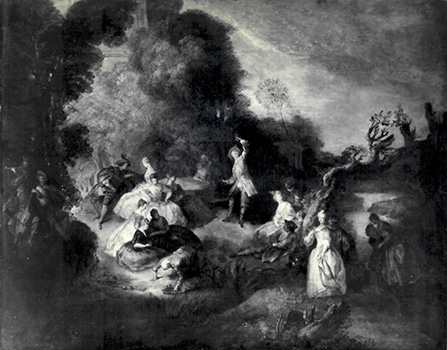 |
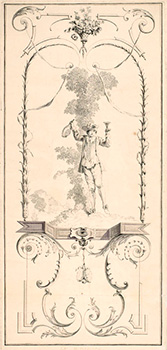 |
| 11. Pierre Antoine Quillard, Le Buveur content, oil on copper, 43 x 53 cm. St. Petersburg, the Hermitage.
|
12. Pierre Aveline after Watteau, Le Buveur, 1738, engraving. |
Quillard's Le Buveur (fig. 11) is exceptional in that its principal character—a gentleman leaping into the air, a flask of wine in one hand, a glass in the other—derives from a figure in a Watteau arabesque. That arabesque has not come down to us, but it was recorded in an engraving in the Oeuvre gravé (fig. 12). However, Quillard would have known Watteau's study from the model or the original painted arabesque. Although Quillard followed his master in painting fêtes galantes, especially embarkations to Cythera and wedding scenes outside country inns, he rarely emulated Watteau's specific figures as he did here.
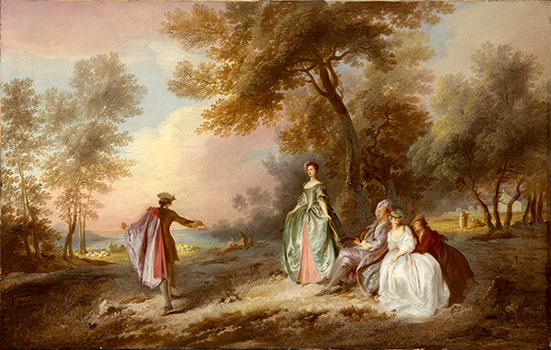 |
| 13. Pierre Antoine Quillard, La Partie quarré, oil on canvas, 86 x 108 cm. Los Angeles, private collection. |
As Quillard's work evolved, while he still was in France (he left in 1726), his figures became more elegant and suave, his colors more lyrical. A fête galante in a California private collection (fig. 13), still evokes Watteau but it is also aligned with the art of Lancret and even François Lemoyne.
If one follows conventional thought, François Jérome Chantereau (c. 1710-15 - 1757) has a central place among the members of the école de Watteau. He is cited by Robert Rey as one of the artist's satellites, and modern scholars such as Per Bjurström describe him in a similar light.6 Yet, whereas paintings by Pater and Quillard ordinarily resemble those of Watteau, Chantereau's rarely do. He favored rural themes, including rustic kitchens and farmyards, and often emphasized vegetables and other elements of still life. All that is far from Watteau's world. Occasionally Watteau ventured in that direction—as in his Ecureuse de cuivre which imitates a kitchen scene by Willem Kalf, and his L'Occupation sélon l'age, which portrays peasants engaged in rustic activities. Yet this was not the main thrust of Watteau's art.
Chantereau occasionally tried his hand at fêtes galantes, although this was definitely not his principal genre. One of his few fêtes galantes is really A Rest after the Hunt, a sub-theme that attracted him because it called for the inclusion of dogs and dead game—motifs that appealed to his interest in still lifes (fig. 14).7 A Chantereau etching of a fête galante is another example of his work in this range of subject matter (fig. 15). At the left side, a boat full of passengers arrives at an island, making this more of an excursion to Cythera than just an ordinary fête galante. The whole of the scene is quite close to Quillard's renditions of the subject, more so than Watteau's. Chantereau represents the evolution or devolution of the later école de Watteau (remembering that he was born after many of Watteau's disciples had already begun painting. His petite manière derives from Watteau, even his Northern interest in peasant life is aligned with the Dutch and Flemish traditions that Watteau and his followers favored, yet his art reflects not only Watteau but also Watteau's pupils.
Although François Octavien has traditionally been listed among Watteau's écoliers, until recently we knew little about him, much less that there were actually two Octavien brothers, both of whom were painters and both shared the same surname: François Senior (c. 1682-1740) and François Junior (c. 1685-1732). The touchstone for fixing the work of the elder brother is the large fête galante he submitted to the Académie royale de peinture et de sculpture in 1725, now in the Louvre. He painted a number of copies and variations on that ambitious composition, such as the one with the Samuels Baumgarte Galerie (fig. 16). Similar characteristics are found throughout his oeuvre—especially the reclining women and comparable distant landscapes rendered in blue. Only occasionally are there echoes of Watteau. In La Sérenade (fig. 17), for example, the attitude of the guitarist standing to the side recalls the musician in Watteau paintings such as L'Enchanteur and La Leçon d'amour, while the woman half-hidden in the shrubbery suggests parallels with a similarly positioned woman in the Berlin version of Le Pèlerinage à l'Ile de Cythère.
François Octavien Junior was not his brother's equal. His paintings were somewhat weaker and less inspired. Tellingly, unlike his brother, he did not become a member of the Académie royale but was, instead, admitted into the Académie de St. Luc. A few of his paintings copy his brother's compositions but normally the two men followed separate paths. Rarely did François Junior emulate Watteau's works. On the other hand, his Winter, one of several variations on the subject, closely follows a composition by Pater, now in the Museu Nacional d'Art de Catalunya, Barcelona (figs. 18, 19).
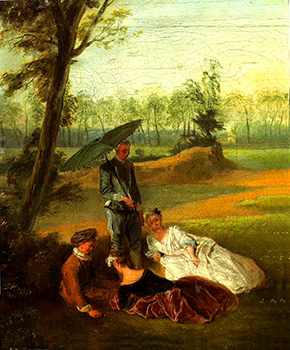 |
| 20. François Octavien Junior, La Sieste, 34.3 x 28 cm. Whereabouts unknown. |
In other, more independent works such as La Sieste, his art shows no particular allegiance to Watteau or other members of the école de Watteau (fig. 20). It is only a generalized recapitulation of ideas associated with French fêtes galantes, which helps explain how it could have been attributed at times to Watteau, Mercier, and Quillard. A few years ago, as yet unaware that there was a junior François Octavien, I hypothecated an otherwise unknown painter whom I called "the Sieste Master." But now, better informed, we can easily recognize the work of Françcois Octavien Junior.
In the wake of Watteau's success, a substantial number of other young artists devoted themselves to copying his compositions, relying on either actual Watteau paintings or engravings published by Jean de Jullienne. The best documented copyist is Charles André Tramblin (d. 1742). Some idea of the prolific nature of his work is suggested by the inventory of the estate of a sieur de Lalande, dated October 21, 1747. It lists an ensemble of at least four copies of engravings after Watteau, as well as others after Lancret, all painted by Tramblin.8 Equally telling, among the works Tramblin left behind in his studio at his death were twenty-four copies after Watteau, as well as twenty-four more copies after Watteau and Lancret.9 Clearly, there was a great demand for such reproductions—something affirmed by the great number of copies by Tramblin and others that have come down to us.
But such copies are not what interest us. Rather, I would prefer to focus on paintings by independent artists, now-anonymous, who were inspired by Watteau and whose works now languish in that vague limbo of "école de Watteau." Because of the great value that we place on named works, there has been a tendency to neglect these nameless masters, yet they too figures in the history of French eighteenth-century painting.
Georges Wildenstein noted that although only two-thirds of the eighteenth-century records of the Paris Guild of St. Luke have survived, these documents contain the names of some two thousand painters who cannot be associated with extant works of art. Among them are probably artists who were followers of Watteau, Pater, Lancret, Mercier, and others who today are classified simply as "école de Watteau." If we cannot attach specific names to these works, their paintings need not be less charming or without skill. A germane example is the essentially unknown Monsieur Porlier, "Peintre dans le genre des fetes galantes" who was agréé to the Académie on September 30, 1752.10 He is probably to be identified with Charles Vincent Porlier, who was admitted as a master painter to the Guild of St. Luke on January 21, 1747—a remarkably late date for someone just beginning to paint in this genre.11 Most important, we cannot identify paintings attributable to him, although there may well be some among the anonymous works of the école de Watteau.
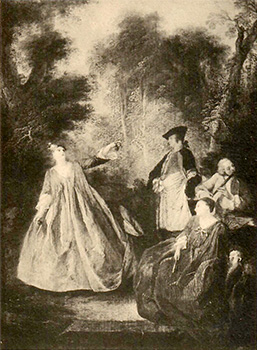 |
| 21. Anonymous French artist, La Danse espagnole, oil on panel, 41 x 30 cm. Whereabouts unknown. |
When a fête galante named La Danse espagnole appeared at auction in 1987, it bore an attribution to Bonaventure de Bar, but the picture has little to do with that Watteau satellite (fig. 21).12 It seems later than Watteau's lifetime, but it does not sufficiently resemble the works of Lancret, Octavien, or de Bar. It is skillfully rendered and pleasantly composed, but who should receive the credit?
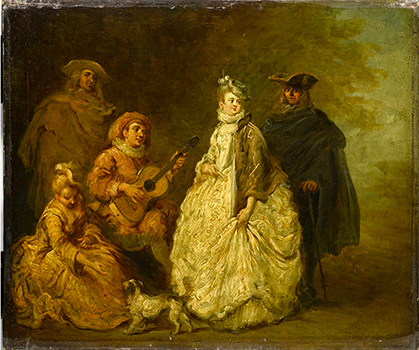 |
| 22. Anonymous French artist, Fête galante, oil on canvas, 34 x 39 cm. collection of the heirs of Marguerite-Louise Stern. |
Another case that has escaped attention until very recently centers on a beguiling but otherwise anonymous fête galante from the école de Watteau (fig. 22). Apparently it was not discussed by Watteau scholars until after World War II, and then only because it figured among the spoils of the Holocaust. Prior to the war it had been in the Parisian collection of Marguerite-Louise and Edgar-Salomon Stern,13 a collection often cited publicly for other works such as a copy of L'Enseigne de Gersaint that was engraved for the Jullienne Oeuvre gravé. But this little fête galante remained in obscurity then, and came to light only recently because of juridical proceedings.
This charming canvas encapsulates the endearing qualities of an otherwise anonymous artist. His work is certainly indebted to Watteau, and it shows no sign of influence from Pater, Lancret, or later satellites. The moody guitarist and the woman playing with a dog could have stepped out of a Watteau fête galante. The standing woman dressed in white is distinctive. She is sweet and particularly diminutive: her head is small in relation to her overall height, a disparity emphasized by the swollen volume of her skirt. The overall effect is quite attractive, and one hopes that more works can be added to the oeuvre of this talented member of the école de Watteau.
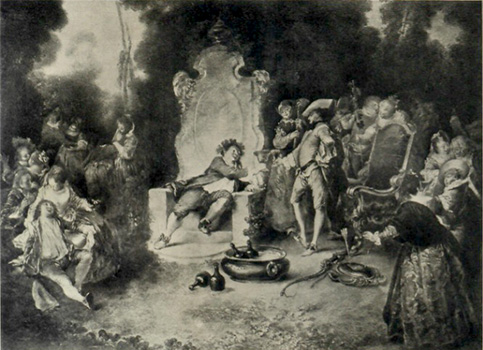 |
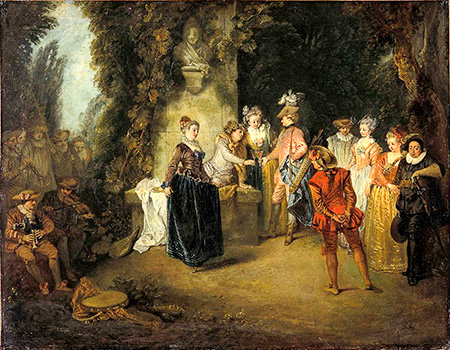 |
| 23. Anonymous French artist, Le Repas de Bacchus, oil on panel, 44 x 61 cm. Whereabouts unknown.
|
24. Watteau, L'Amour au théâtre français, oil on canvas, 37 x 48 cm. Berlin, Gemäldegalerie. |
An artist of a very different temperament is one who was inspired by specific compositions by Watteau, but who treated them in a comic, almost burlesque manner. His Repas de Bacchus typifies his work (fig. 23)14 In the late nineteenth century the picture was attributed to Watteau. When it was sold from the Roussel collection in 1893, not only was it given to Watteau but, also, it was claimed that a partial signature—"A. Watt"—was visible on Bacchus' throne. It was rightly pointed out that the Roussel picture was a variation on Watteau's L'Amour au théâtre français (fig. 24) but the two paintings have little specific in common beyond the central figures of the seated Bacchus and his drinking companion, Apollo. In both the central actors similarly lift their glasses in a toast, but the other characters are quite different, and style-wise there is a great gulf between the two paintings. Zimmerman recognized that the Roussel picture was not by Watteau, and thus he included it in a section of "tableaux d'attribution discuté."15 Ingersoll-Smouse rightly challenged an attribution to Pater, and Adhémar wrongly favored an attribution to the late eighteenth-century French painter Jean Frédéric Schall (1752-1825).16
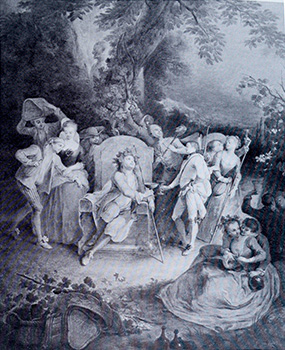 |
| 25. Anonymous artist, Le Repas de Bacchus, 117 x 91.5 cm. Whereabouts unknown. |
A larger, vertical version of the ex-Roussel composition appeared on the New York market a half century ago, then attributed to the school of Lancret (fig. 25).17 The central figures of Bacchus and Apollo, but not the throne, resemble the ex-Roussel painting. The other characters assume quite different poses, and are less rotund and convivial. Yet it seems unlikely that two different artists were responsible for rendering separate versions of this unique composition.
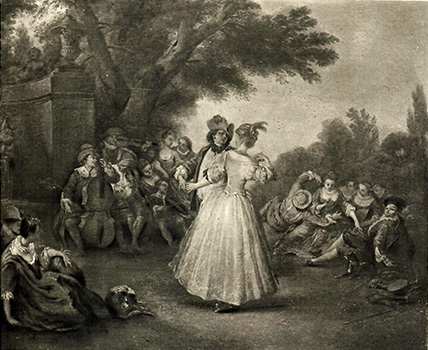 |
| 26. Anonymous French artist, La Danse, oil on canvas, 51 x 63 cm. Whereabouts unknown. |
A pair of fêtes galantes from the Lelong collection that appeared at auction a century ago may be by the same painter as the Repas de Bacchus.18 Both Lelong pictures have as their central motif a dancing couple, but only one was illustrated at that time (fig. 26). In character and style, the dancer in that painting is analogous to the Bacchus in Repas de Bacchus. La Danse contains occasional reflections of Watteau. For example, the man in the right background, recumbent on the ground and with his arms raised awkwardly, and his companions engaged in a concert, echo a group in Watteau's L'Accord parfait. The pendant featured three figures in the foreground, including a woman with a musical partbook and a guitarist, and other figures farther back. The Lelong paintings have not reappeared in public in more than a century, and would seem to be lost to us.
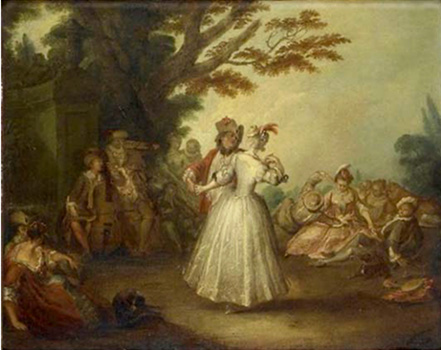 |
| 27. Anonymous French artist, Le Menuet, oil on canvas, 59 x 71.5 cm. Whereabouts unknown. |
A slightly larger version of the Lelong La Danse, with the very same composition but a different landscape background, has come to light (fig. 27).19 It apparently traveled under the name of Philippe Mercier during the latter part of the twentieth century, but when it appeared at auction in 2010 under the title Le Menuet, there was no reference to the Lelong pictures, and it was classified as being by an eighteenth-century follower of Watteau. There is no apparent reason to doubt that the two versions of this composition are by the same hand, that of an anonymous member of the école de Watteau.
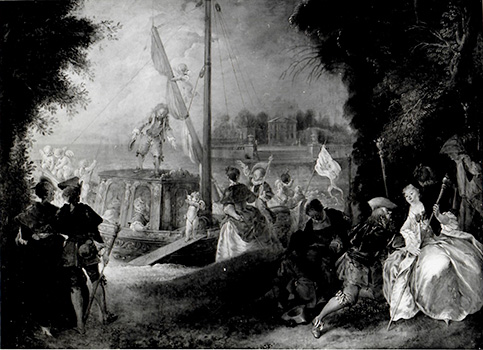 |
| 28. The Jovial Master, Pèlerinage à Cythère, oil on panel, 43.5 x 60.5 cm. Whereabouts unknown. |
Yet another member of the école de Watteau, one who has left behind a sizable corpus of works, is an artist whom, faute de mieux, I have named the Jovial Master because so many of the characters in his paintings are joyous and smiling, if not laughing. A work that convincingly places him in the context of Watteau is his version of the Pèlerinage à Cythère (fig. 28).20 Lacking Watteau's poetic grace, the Jovial Master's rendition is overly active, bubbling with excitement. The smiling woman and her suitor in the right corner capture the spirit of his works. Prior to World War II, this painting was presented under Quillard's name, and whereas that might have been excusable in the 1930s when Quillard's oeuvre was not fully charted, the association is no longer tenable.
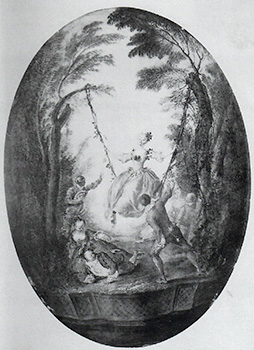 |
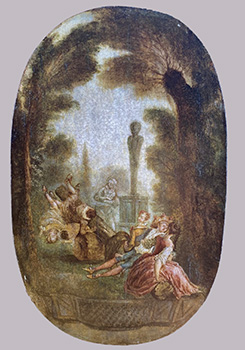 |
| 29. The Jovial Master, L'Escarpolette, oil on panel, 41 x 36 cm. Paris, private collection.
|
30. The Jovial Master, La Bascule, oil on panel, 41 x 36 cm. Canada, private collection. |
Among this artist's distinctive works are a pair of decorative pictures, one featuring a woman on a swing, and the other a group of men and women playing on a seesaw (figs. 29, 30).21 The two paintings were together in the mid-nineteenth century when they were in the collection of the comte de Monbrun, where they were attributed to Watteau.22 They were still together and still attributed to Watteau when they were sold in 1892 from the Anatole Hulot collection.23 Apparently, the pendants were then separated. L'Escarpolette was bought at the Hulot sale by the wife of Edouard André, and then passed to her cousin, the comte de Cornudet—still under Watteau's name. Under an attribution to Sebastien Jacques Leclerc (1733-1785), L'Escarpolette came up for sale in 1988.24 There has been a renewed attempt to reinstate an attribution to Watteau, but there is no reason to think that the idea will gain traction. The pendant picture, La Balanceuse, fell from sight in the twentieth century, and re-emerged only recently, with an attribution to the école de Watteau.
L'Escarpolette suggests analogies with a number of fête galantes by Watteau, but more so with renditions by Pater and Lancret, especially because of its quickened sense of movement and frivolity. Unlike the sedate women on swings in such scenes by Watteau, here the lady smiles quite openly and her face, with its small features, typifies the artist's style. Much energy is displayed here: her suitor energetically lunges as he guides the rope, and a second man has stumbled as he tries to avoid the path of her swing. The Jovial Master particularly favored figures fallen or falling to the ground, and this motif is seen as well in La Bascule.
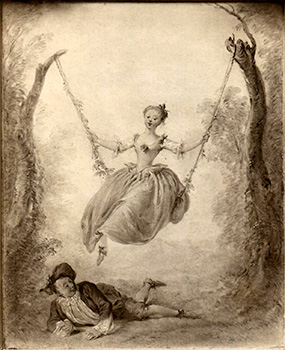 |
| 31. The Jovial Master, L'Escarpolette, 29 x 24 cm. Whereabouts unknown. |
It has escaped attention that there is a smaller, reduced version of L'Escarpolette (fig. 31).25 Only the woman and the man fallen to the ground from the larger painting were retained, and their general style and facial features are the same in the larger version. When the reduced version was auctioned, it too was attributed to Watteau, yet no ascription could be farther from the truth.
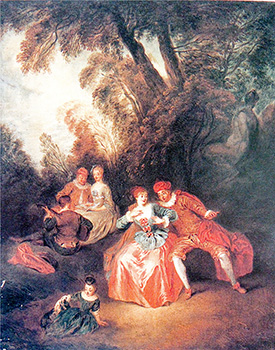 |
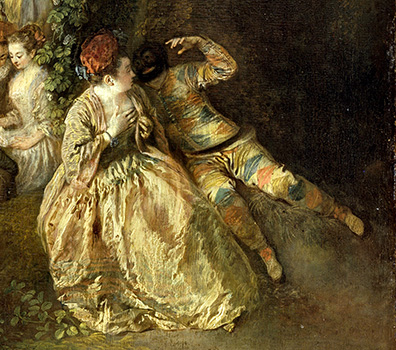 |
| 32. The Jovial Master, Fête galante, oil on canvas, 55.3 x 46 cm. Whereabouts unknown.
|
33. Watteau, Voulez-vous triompher des belles? (detail), oil on oak panel. London, Wallace Collection. |
The Jovial Master's indebtedness to Watteau is seen in a fête galante whose attribution until now has centered on the circle of Pater (fig. 32).26 Unlike Watteau's manner in most ways, nonetheless, his influence is very much present here. The central motif of the actress pulling back defensively, her hand over her breast, recalls Watteau's Voulez-vous triompher des belles? (fig. 33). So too, the trio of a musician seen from behind and a man and woman intent on a musical score are from that same Watteau composition. Likewise, the girl in the foreground playing with her dog echoes the similarly positioned children in so many Watteau fêtes galantes such as Les Champs-Elysées. While this painting's artistic pedigree is traceable to Watteau, the elongated proportions of the principal actors as well as their small heads and the definition of their facial features point to an artist with his own artistic identity. He is not Watteau nor is he Pater. Rather, he is yet-to-be identified—an artist whose hand can be found in a number of works associated with the école de Watteau.
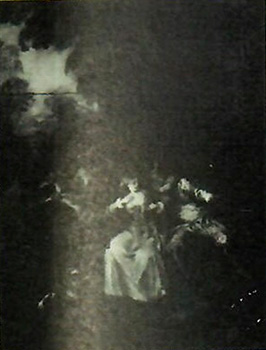 |
-sampled.jpg) |
| 34. The Jovial Master, Fête galante, oil on canvas, 48 x 37 cm. Whereabouts unknown.
|
35. The Jovial Master, Fête galante (detail). |
There is a second, slightly smaller version of this same composition (figs. 34, 35).27 The treatment of the facial features is more heavy-handed, the background trees differ, and its wood panel with slightly different measurements distinguish it from the first composition. Ferré published both under the unsuitable title "Don Juan" as if they were one and the same work.
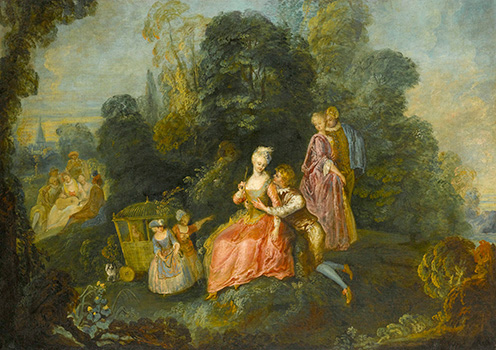 |
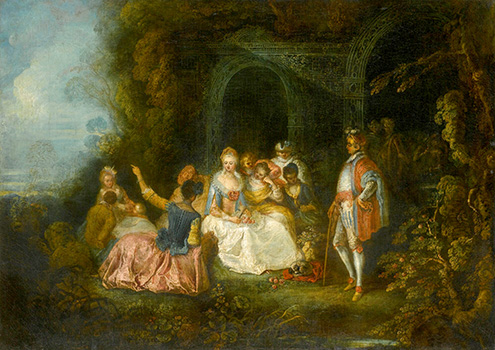 |
| 36. The St.-Cloud Master, L'Escamoteur, oil on canvas, 84 x 117 cm. Whereabouts unknown.
|
37. The St.-Cloud Master, Le Repos à la fontaine, oil on canvas, 84 x 117 cm. Whereabouts unknown. |
A very different effect is seen in a distinctive pair of paintings, both fêtes galantes and with unusual features (figs. 36, 37).28 In the nineteenth century, when they were in the collection of the marquis de St.-Cloud, the pendants were given to Watteau himself. They feature amorous couples and children, posed much as we would expect in his fêtes galantes. The kneeling man courting a woman in L'Escamoteur is very close to a couple in a Watteau drawing recorded in plate 132 of the Figures de différents caractères. Other elements in the paintings are unlike Watteau. The terrain in L'Escarpolette is hilly and uneven, and the inclusion of a miniature carriage for the children is too specific for Watteau's more ethereal scenes. Not least, although Watteau-like, the figures are overly elongated to be attributed to Watteau. Recently, the paintings have been attributed to Quillard, perhaps a better choice than others, but not at all correct.29
……………………………………………
The minor masters who followed in the wake of Watteau's success are more numerous than we had perhaps imagined. Far from being restricted to the handful catalogued a century ago by Robert Rey, their ranks and their variety are greater. Moreover, the anonymous painters presented here by no means exhausts the list of artists eligible for candidacy in the école de Watteau. Although never a major mode in comparison with historical and religious subjects, fêtes galantes enjoyed a larger share of the Paris art market than they had been credited with, even if not for a long span of time. Watteau died in 1721, and not only did some of his followers subsequently leave France but others were remarkably short-lived. About 1719, while Watteau was still alive, Mercier departed for London. Then, just five years after his master's death, Quillard left for Portugal. Bonaventure de Bar died young—as early as 1729; Pater died in 1736; and Lancret in 1743. Chantereau outlived them all, surviving until 1757. One wonders if any of the unnamed followers that we have considered in these pages remained active in the years after mid-century, helping to bridge the interval between Watteau and Fragonard. It should be remembered that the otherwise obscure artist Porlier was agrée to the Académie royale as a painter of fêtes galantes as late as 1752. The école de Watteau encompassed a surprisingly large group of artists who in their own ways reflected and extended the art of their master—through the first half of the eighteenth century and perhaps beyond. Clearly, there is much more to be explored.
NOTES
1 See Florence Raymond, "Antoine Watteau et Jean-Baptiste Pater: Nouvelles perspectives materielles sur les dessins du maître et de son élève," in Axel Moulinier, ed., L'Univers de Watteau. Reseaux et influences autour d'Antoine Watteau (1684-1721) (Paris: 2022), 123-33.
2 Yuriko Jackal, "On Influence and Inspiration, Watteau and Pater," in Moulinier, L'Univers de Watteau," 133-41.
3 On the association of the two artists, see Martin Eidelberg, "The Young Lancret and Watteau," Watteau and His Circle, http://watteauandhiscircle.org/younglancret.htm.
4 Martin Eidelberg, "Philippe Mercier, Watteau's English Follower," Watteau and His Circle, http://watteauandhiscircle.org/Mercier.htm.
5 For more on this painting see Eidelberg, "Danceur aux castagnettes," Watteau Abecedario, http://watteau-abecedario.org/x_danseurauxcastagnettes.htm.
6 Rey, Quelques satellites de Watteau, 161-83. Per Bjurström, "François-Jérome Chantereau, dessinateur," La Revue de l'art (1971), 80-85.
7 The painting illustrated here is a work that was wrongly ascribed to the circle of Lancret when it appeared in a Budapest sale of the collection of Prince Rakoczy, April 28, 1930, lot 198.
8 Georges Wildenstein, Rapports d'experts 1712-1791 (Paris: 1921), pp. 44-45.
9 Jules Guiffrey, Scellés et inventaires d'artistes français du XVIIe et du XVIIIe siècle, 3 vols.(Paris: 1885-86), 1: pp. 20-21.
10 Académie royale de peinture et de sculpture. Procès-verbaux de l'Académie royale de peinture et de sculpture, 1648-1793, 10 vols. (Paris: 1875-92), 5: pp. 331, 333-35.
11 Georges Wildenstein, Mélanges, 2 vols. (Paris: 1925-26), 2: p. 217.
12 Paris, sale, Hôtel Drouot, March 17, 1987, lot 121.
13 For this painting's history, see Rose Valland (MNR-Jeu de Paume), réf. MNR00890. It supposedly figured in a sale at the Hôtel Drouot on January 18, 1928, but it has not been possible to confirm this.
14 Its first recorded appearance is in the sale of the H. D. Roussel collection, Brussels, Galerie Saint-Luc, May 23-24, 1893, cat. 23. The picture was supposedly stolen during World War I.
15 See Heinrich Zimmerman, Watteau, des Meisters Werke (Stuttgart and Leipzig: 1912), no. 160.
16 See Florence Ingersoll-Smouse, Pater (Paris: 1928), cat. 570; Hélène Adhémar, Watteau, sa vie–son oeuvre (Paris: 1950), cat. 269
17 New York, sale, Parke-Bernet, March 15, 1974, lot 27.
18 Paris, sale, Galerie Georges Petit, collection Madame C. Lelong, May 11-15, 1903, cat. 574-75.
19 Versailles, sale, Versailles Enchères, October 24, 2010, lot 93.
20 The painting was presented as a Quillard in London, Wildenstein Gallery, Watteau and His Contemporaries (1936), cat. 22. It then appeared at auction in Versailles, sale, Trianon, March 14, 1962, lot 66, as "attribué à Quillard." It is listed by Ferré, Watteau, cat. P 23, and discussed by me in "The Jovial Master," Watteau and His Circle, http://watteauandhiscircle.org/Jovial-Master.htm.
21 For these two paintings, see Martin Eidelberg, "The Jovial Master," Watteau and His Circle," Watteau Abecedario, http://watteauandhiscircle.org/Jolly-Master.htm; see also Nicolas Sainte Fare Garnot, "Réflexions sur L'Escarpolette d'Édouard André," in De Watteau à Fragonard, (Paris: 2014), pp. 26-29.
22 Paris, sale, Hôtel des commissaires-priseurs, collection of the comte de Monbrun, February 4-7, 1861, lots 43-44.
23 Paris, sale, Galerie Georges Petit, collection of Anatole Hulot, May 9-10, 1892, lot 125.
24 Paris, sale, Hôtel Drouot Richelieu, May 31, 1988, lot 21.
25 Berlin, sale, unknown date, collection K. W. Bachnitz(?). The latter name—somewhat indistinct—appears on the verso of an old photograph in the Getty Research Library.
26 London, sale, Sotheby's, April 20, 1994, lot 123; Vienna, sale, Dorotheum, December 11, 2018, lot 354. On each occasion the picture was classified as "follower of" or "circle of" Pater.
27 Ferré, Watteau, 3: pp. 242-43, cat. B 15. Ferré's classmark "B" signifies "peintures attribuées à Watteau."
28 For these paintings, see "L'Escamoteur" and "Le Repos à la fontaine" in Watteau Abecedario, Doubtful Attributions, http://watteau-abecedario.org/X_Escamoteur.htm; http://watteauabecedario.org/X_Repos_a_la_fontaine.htm.
29 London, sale, Sotheby's, April 10, 2013, lot 157, as "attributed to Pierre-Antoine Quillard." Paris, Tajan, December 11, 2013, lot 44, as "attribué à Pierre-Antoine Quillard." Versailles, Chevau-Legers Enchères, February 23, 2014, lot 35, as "attribué à Pierre-Antoine Quillard." Versailles, Chevau-Legers Enchères, June, 22, 2014, lot 23, as Ecole de Watteau." Paris, Hôtel Drouot, June 24, 2015, lot 24, as "attribué à Pierre-Antoine Quillard." Paris, Tajan, March 22, 2018, lot 76, as "attribué à Pierre-Antoine Quillard." Paris, Leclerc, July 2, 2019, lot 50, as "attribué à Pierre-Antoine Quillard." The paintings were also exhibited in Pèlerinage à Watteau (Paris: Hôtel de la Monnaie, 1977), cat. 188-89, listed merely as French eighteenth-century works.